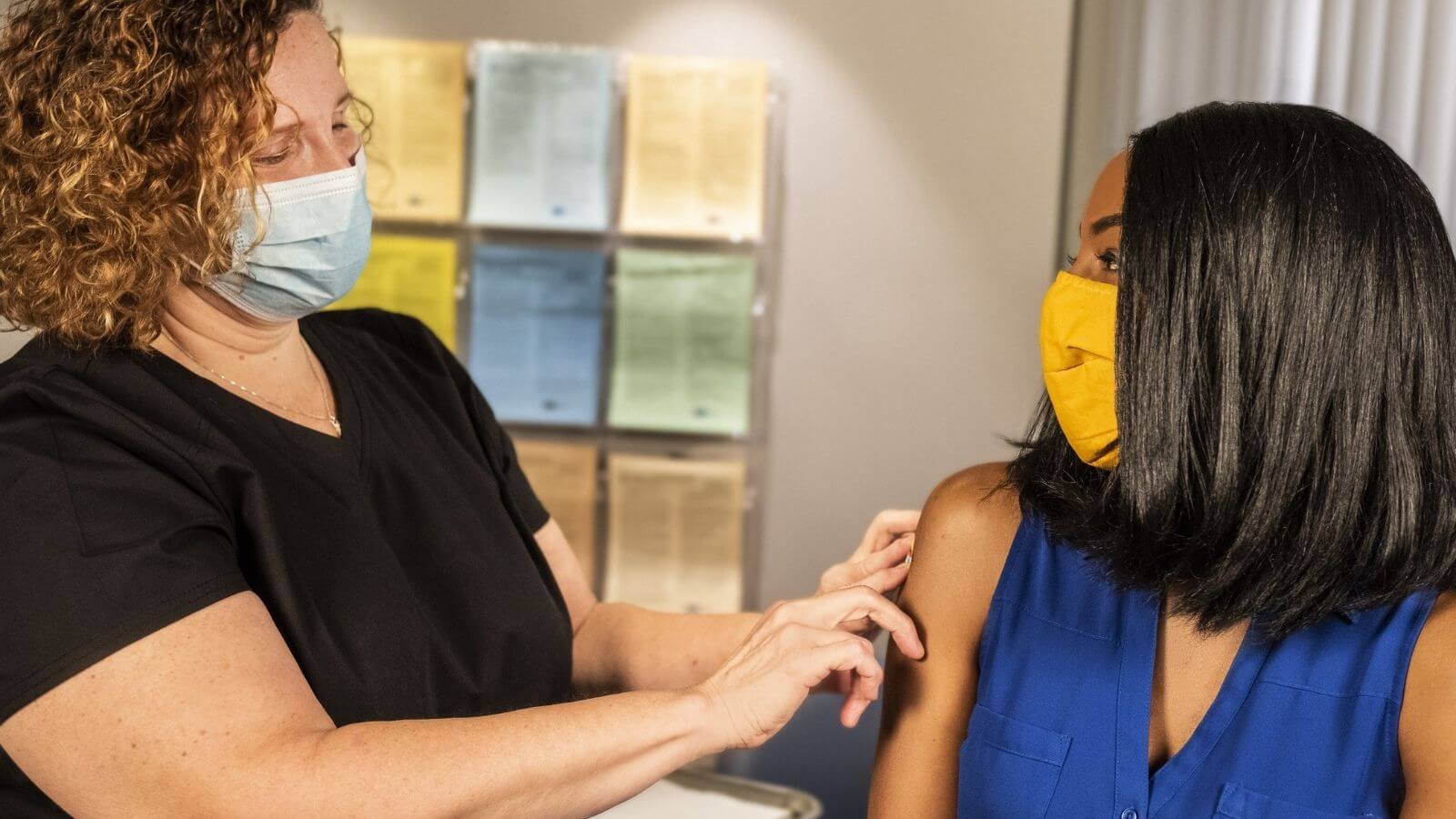On November 5, 2021, the U.S. Occupational Safety and Health Administration (OSHA) published an Emergency Temporary Standard (ETS) regarding COVID-19. The ETS establishes new requirements for covered employers with 100 or more employees. In total, OSHA estimates these rules will affect over 264,000 employers and 84 million employees. The ETS gives employers the option to require all employees to become vaccinated against COVID-19 or implement weekly testing and mask-wearing requirements for all unvaccinated workers. The ETS is already subject to litigation that could block the OSHA vaccine mandate from taking effect. But, if not, employers must begin complying with its provisions by December 6, 2021.
Coverage – Who is subject to the ETS?
The OSHA vaccine mandate ETS doesn’t apply universally. And, unfortunately, who is or isn’t covered isn’t always a simple question.
Covered Employers
100 Employee Threshold
The employing entity must have at least 100 employees for the ETS to apply. But not all organizations with 100 or more employees are covered.
The 100 employee threshold is across all of the employer’s operations. There doesn’t have to be any single workplace with that many workers. Even separate legal entities can be treated as a single employer for this purpose if they handle safety matters collectively.
OSHA has identified special parameters when a staffing agency is involved. Only the staffing agency, and not the site operator, must count the workers it supplies to a worksite. However, if the staffing agency has 100 or more employees, the site operator would still have obligations as a joint employer to ensure those workers comply with the ETS.
In counting employees, part-time employees count equally as full-time employees. There is no calculation of full-time equivalents (FTEs). However, genuine independent contractors aren’t counted.
If an employer has 100 or more employees on any day during the effective period of the ETS, then the employer remains subject to the ETS as long as it remains in effect. A subsequent decline in headcount does not remove the employer from coverage.
Public Employees
The Occupational Safety and Health Act only applies directly to private-sector workplaces. However, many states have agreements to apply OSHA’s requirements or alternate more stringent standards on state and local governmental entities. Public employees in states with such plans in place would generally be expected to be subject to the ETS, provided their employing governmental entity has 100 or more employees and isn’t subject to another carveout. However, some states are likely to contest OSHA’s vaccine mandate, making the ultimate impact on public workers uncertain.
Federal Contractors
President Biden’s Executive Order 14042 subjects many federal contractors and subcontractors to alternate COVID-19 vaccine requirements. Workplaces subject to that more stringent vaccine mandate are not subject to the OSHA ETS. However, employers may be subject to both the federal contractor rules and the OSHA rules at separate workplaces or for different groups of employees.
Note that the vaccine mandate for federal contractors was previously set to take effect beginning December 8, 2021. However, as a slight concession for consistency, the White House has changed that date to January 4, 2022. That is the deadline for employees to be vaccinated under the OSHA ETS.
Healthcare Settings
On June 21, 2021, OSHA implemented an ETS addressing COVID-19 in certain healthcare settings. It’s not easy to describe which healthcare workplaces are subject to those rules. OSHA has prepared a complicated flowchart to help reach that determination.
Notably, the healthcare ETS does not require vaccination. Nonetheless, workplaces subject to the earlier, and still operable, healthcare ETS, such as acute care hospitals, are excluded from coverage under the November OSHA vaccine mandate ETS. But, healthcare providers with workplaces not covered by the healthcare ETS may be subject to the OSHA vaccine mandate for employees in those settings, if otherwise applicable based on employee count and other possible exclusions.
Covered Employees
Unless an express exception applies, the OSHA ETS applies to all employees of covered employers.
The OSHA requirements do not apply to employees:
- who do not report to a workplace where other individuals, such as coworkers or customers, are present;
- while working from home; or
- who work exclusively outdoors.
Some exceptions are also permitted as accommodations to employees based on medical conditions or religious beliefs.
Vaccine Mandate
The OSHA ETS prefers that covered employers implement a mandatory vaccination policy for all covered employees. The deadline for employees to complete their vaccination sequence (one or two shots depending on the vaccine) is December 4, 2021. After that date, all new employees must become vaccinated “as soon as practicable.”
Employers who choose to require full vaccination of all employees may still make exceptions for employees:
- for whom a vaccine is medically contraindicated;
- for whom medical necessity requires a delay in vaccination; or
- who are legally entitled to a reasonable accommodation under federal civil rights laws because they have a disability or sincerely held religious beliefs, practices, or observances that conflict with the vaccination requirements.
OSHA’s allowance of these exceptions does not necessarily mean that all such employees must be allowed to work without being vaccinated. The ETS only provides an available exception from the mandate in these instances. Employers must comply with any applicable legal obligations, such as making disability and religious accommodations. But there may be situations where an exception from the mandate would not be a reasonable accommodation or would pose an undue hardship.
Test/Mask Option
As an available alternative to a complete vaccination mandate, employers may enact a policy of allowing unvaccinated employees to continue working by testing for COVID-19 weekly and wearing face coverings while working.
Testing
Covered employees who report at least once every 7 days to a workplace where other people are present must test weekly. In this scenario, each employee must provide documentation of the most recent COVID-19 test result to their employer by the 7th day following the date they last provided a test result.
Whenever an employee goes at least 7 days without reporting to a workplace where other people are present, the employee must be tested within 7 days before returning to the workplace and provide the test results upon return to work.
The OSHA ETS does not require employers to pay for COVID-19 testing. However, it acknowledges and permits that other laws or contractual obligations (such as union collective bargaining agreements) may impose such a requirement.
Whether vaccinated or not, any covered employee who tests positive must inform their employer and remain out of the workplace during any applicable isolation periods.
Face Coverings
Covered employees who are not fully vaccinated must wear a face covering at work whenever they are indoors or in a vehicle with another person.
There are several limited exceptions to the mask requirement:
- When alone in a room with floor-to-ceiling walls and a closed door.
- For a limited time while eating or drinking at the workplace or for identification purposes in compliance with safety and security requirements.
- When wearing a respirator or facemask (technically different from a “face covering” for OSHA purposes).
- Where the employer can show that the use of face coverings is infeasible or creates a greater hazard.
Employers must ensure that face coverings fully cover employees’ mouths and noses and are replaced when wet, soiled, or damaged.
OSHA does not require employers to pay for or provide face coverings. But it acknowledges and permits that employers may have independent legal obligations to do so.
Employee Vaccination Status
All covered employers must determine and keep a readily available roster of the COVID-19 vaccination status of all covered employees, regardless of whether they impose a strict vaccine mandate or permit the testing/masking option.
Employers must obtain acceptable proof of full or partial vaccination status of each covered employee.
Where the employee cannot provide a vaccination card or other official documentation, a signed statement from the employee may be accepted. The attestation must specifically include the following language:
I declare (or certify, verify, or state) that this statement about my vaccination status is true and accurate. I understand that knowingly providing false information regarding my vaccination status on this form may subject me to criminal penalties.
OSHA warns that employers who knowingly permit false documentation of vaccination status may also be subject to severe penalties.
Paid Leave
The OSHA ETS requires that all covered employers provide “a reasonable amount of time,” of up to 4 hours of paid leave, for employees to obtain each vaccination dose.
Moreover, employers must also provide “reasonable time and paid sick leave” for employees to recover from side effects experienced after a vaccination dose. OSHA comments that a reasonable time is up to two days in most cases. Employers may require employees to use available paid sick or PTO time for this purpose, if available. But employees who do not currently have such time available must still be granted time off with pay.
These requirements only cover the primary one or two-dose regimens, not any potential booster shots.
Written Policies
Whether employers impose a strict vaccine mandate or a testing option, they must prepare a written policy addressing all of the OSHA COVID-19 requirements.
Specifically, covered employers must inform all employees “in a language and at a literacy level the employee understands” about:
- The requirements of the OSHA ETS and any employer policies and procedures established to implement it.
- COVID-19 vaccine efficacy, safety, and benefits of being vaccinated, by providing the document “Key Things to Know About COVID-19 Vaccines”.
- OSHA rules that prohibit employers from discharging or in any manner discriminating against an employee for reporting a work-related injury or illness and for exercising rights under the OSHA COVID-19 ETS.
- Federal laws providing for criminal penalties associated with knowingly supplying false statements or documentation.
OSHA has provided sample policies on its website:
OSHA’s samples may provide a helpful starting point, but most employers will need to revise them carefully to match the relevant circumstances in their workplaces. And some employers may decide to adopt different policies for different facilities or categories of employees, which is generally an available option under the ETS.
Reporting Requirements
Employers must also report work-related COVID-19 in-patient hospitalizations and fatalities to OSHA. Hospitalizations must be reported with 24 hours of the employer learning of them. Fatalities must be reported within 8 hours.
Penalties
Covered employers could face penalties of up to $13,653 per violation of the OSHA ETS. Penalties for repeated and willful violations may reach up to $136,532 for each offense. Proposed legislation could increase those penalties by up to 10 times their current amounts.
Legal Challenges
As soon as President Biden announced that he was asking OSHA to work on a vaccine mandate, legal experts began questioning the agency’s authority to do so. Many interested parties have objected to this regulatory action, including numerous businesses and some states. The day after the OSHA ETS was published in the federal register, the U.S. Court of Appeals for the 5th Circuit issued a ruling preventing the ETS from taking effect pending further action by the court. The 5th Circuit found “cause to believe there are grave statutory and constitutional issues” with the OSHA vaccine mandate.
The 5th Circuit case is not the only one expected to be processed in an expedited manner given the ETS’s initial December 6th compliance date. Yet, at this point, it is unknown exactly when any final decision, potentially from the U.S. Supreme Court, will be rendered.
For now, covered employers must prepare for the possibility of having to comply on short notice. But there is also a reasonable chance that some or all of the OSHA ETS’s provisions will never become applicable.
For more analysis of the OSHA vaccine mandate ETS, register for our upcoming webinar.


